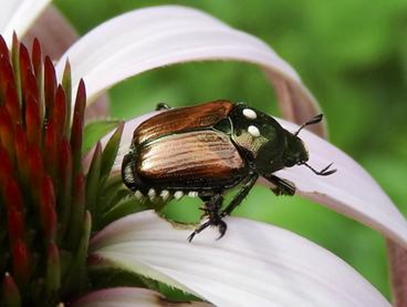Bill Hutchison, Extension Entomologist, Ellie Meys, Undergraduate Student, & Erin Buchholz, Plant Health Specialist, Landscape Arboretum, University of Minnesota
Although Japanese beetle (JB) adults continue to be active
throughout August to early September, we shared good news last week that
beetle numbers on most host plants/crops are beginning to decline. The gradual
reduction in adult populations is due to several factors, including the end of
local emergence “curve” this time of year, but also reflects the impact of
several natural mortality factors. One of these factors is biological control,
specifically the Winsome fly (WF) (Istocheta
aldrichi: Family Tachinidae), which lays its distinctive white eggs quite
conspicuously just behind the head of JB adults (i.e., the pronotum; see photo,
2020). As noted in the photo, the fly can lay one, two, three, or more eggs on
one beetle; however, only one parasitic larva will survive to kill the beetle.
Within a few days of egg-lay on JB, the parasitic larva will hatch, and with “serrated”
mouthparts bore through the host cuticle and begin feeding. Although, the
biology of the fly has not been well-studied, most reports indicate JB adults
will die within 6-7 days – not quite as fast acting as an insecticide, but
still impressive.
In addition, previous reports and recent field findings indicated
that WF females prefer to lay their eggs on JB females. From a population
ecology and IPM perspective, this is a highly valuable trait. Females dying
within 6-7 days will not likely be able to lay their full complement of eggs,
thus providing population suppression within the same summer, and potentially
contribute to longer-term suppression the following year.
Winsome fly in
Minnesota: From 1998 to 2006, several releases of WF were made in
Minnesota, by the USDA and MDA. The majority of releases were conducted in
Dakota, Hennepin and Ramsey counties. In addition, until recently, only small
percentages of JB adults were found to be parasitized by WF, including 1-10% in
2017-2018, respectively, in apple orchards (Dakota, Washington counties; see
Shanovich et al. 2021). By contrast, during the past two summers, we have
observed a significant and consistent increase in parasitism rates by WF.
Recent data from the Landscape Arboretum (Carver Co.), in ornamental garden
settings, as well as WF parasitism data from two commercial vineyards and one
research vineyard, are summarized in Table 1. Moreover, we verified (as with
other studies) that female JB were preferred for WF egg-lay, compared to males,
with preference for females ranging from 55-81%.
Table 1. Percentage parasitism by Winsome Fly on Japanese beetle
adults, for selected MN locations, 2022-2023
Year Location* Percentage
(%) Parasitism by Winsome Fly
Avg. Peak Preference:
Female vs M (%)
2022 Arb-Sensory
Garden Trap 8 14
----
Arb-Woodland
Azalea Trap 13 29 ----
2023 Arb-Sensory
Garden Trap 23 33 ----
Arb-Woodland
Azalea Trap 22 59 ----
Alexis-Bailly Vineyard Trap 7 15 81
Hort.
Res. Center Vineyard Trap 28 39 55
Sovereign
Estate Vineyard Trap 11 18 73
*Arb sites =
Landscape Arboretum, University of Minnesota (Carver Co.); Cooperating
wine-grape growers: Alexis-Bailly (Dakota Co.); Hort. Res. Center (HRC),
Chanhassen and Sovereign Estate, Waconia (Carver Co.)
Although the results shown in Table 1 are based on JB
collected in commercial JB traps, we have also observed similar parasitism
rates for JB collected directly from plants (wild grape). To date, WF activity,
as measured by the presence of eggs on JB, has been limited to reports from
Hennepin, Ramsey, Dakota, Washington and now Carver counties. More work is
underway and planned for 2024, to extend our survey within and beyond the Metro
region, to further understand the impact of the parasitoid. For more details on
JB management in fruit crops, growers should review the JB Pest Profile on the FruitEdge
web page.

Comments
Post a Comment